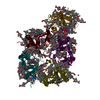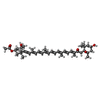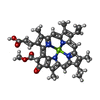+ Open data
Open data
- Basic information
Basic information
| Entry | Database: PDB / ID: 8jp3 | ||||||
|---|---|---|---|---|---|---|---|
| Title | FCP trimer in diatom Thalassiosira pseudonana | ||||||
 Components Components | Fucoxanthin chlorophyll a/c protein 8 | ||||||
 Keywords Keywords | PHOTOSYNTHESIS / FCP trimer | ||||||
| Function / homology |  Function and homology information Function and homology informationlight-harvesting complex / photosynthesis, light harvesting in photosystem I / plastid / chlorophyll binding / response to light stimulus / membrane Similarity search - Function | ||||||
| Biological species |  Thalassiosira pseudonana CCMP1335 (Diatom) Thalassiosira pseudonana CCMP1335 (Diatom) | ||||||
| Method | ELECTRON MICROSCOPY / single particle reconstruction / cryo EM / Resolution: 2.73 Å | ||||||
 Authors Authors | Feng, Y. / Li, Z. / Zhou, C.C. / Liu, C. / Shen, J.R. / Wang, W. | ||||||
| Funding support |  China, 1items China, 1items
| ||||||
 Citation Citation |  Journal: Plant Commun / Year: 2024 Journal: Plant Commun / Year: 2024Title: Structural and spectroscopic insights into fucoxanthin chlorophyll a/c-binding proteins of diatoms in diverse oligomeric states. Authors: Cuicui Zhou / Yue Feng / Zhenhua Li / Lili Shen / Xiaoyi Li / Yumei Wang / Guangye Han / Tingyun Kuang / Cheng Liu / Jian-Ren Shen / Wenda Wang /   Abstract: Diatoms, a group of prevalent marine algae, significantly contribute to global primary productivity. Their substantial biomass is linked to enhanced absorption of blue-green light underwater, ...Diatoms, a group of prevalent marine algae, significantly contribute to global primary productivity. Their substantial biomass is linked to enhanced absorption of blue-green light underwater, facilitated by fucoxanthin chlorophyll a/c-binding proteins (FCPs), exhibiting oligomeric diversity across diatom species. Utilizing mild CN-PAGE analysis on solubilized thylakoid membranes, we displayed monomeric, dimeric, trimeric, tetrameric and pentameric FCPs in diatoms. Mass spectrometry analysis revealed each oligomeric FCP has specific protein compositions, constituting a large Lhcf family of FCP antennas. In addition, we resolved the structures of Thalassiosira pseudonana FCP (Tp-FCP) homotrimer and Chaetoceros gracilis FCP (Cg-FCP) pentamer by cryo-electron microscopy at 2.73 Å and 2.65 Å resolutions, respectively. The distinct pigment composition and organization in various oligomeric FCPs change their blue-green light-harvesting, excitation energy transfer pathways. In comparison to dimeric and trimeric FCPs, Cg-FCP tetramer and Cg-FCP pentamer exhibit stronger absorption by Chls c, red-shifted and broader Chl a fluorescence emission, as well as more robust circular dichroism signals originating from Chl a-carotenoid dimers. These spectroscopic characteristics indicate that Chl a molecules in Cg-FCP tetramer and Cg-FCP pentamer are more heterogeneous than in both dimers and Tp-FCP trimer. The structural and spectroscopic insights provided by this study contribute to a better understanding of the mechanisms that empower diatoms to adapt to fluctuating light environments. | ||||||
| History |
|
- Structure visualization
Structure visualization
| Structure viewer | Molecule:  Molmil Molmil Jmol/JSmol Jmol/JSmol |
|---|
- Downloads & links
Downloads & links
- Download
Download
| PDBx/mmCIF format |  8jp3.cif.gz 8jp3.cif.gz | 181.8 KB | Display |  PDBx/mmCIF format PDBx/mmCIF format |
|---|---|---|---|---|
| PDB format |  pdb8jp3.ent.gz pdb8jp3.ent.gz | 154.5 KB | Display |  PDB format PDB format |
| PDBx/mmJSON format |  8jp3.json.gz 8jp3.json.gz | Tree view |  PDBx/mmJSON format PDBx/mmJSON format | |
| Others |  Other downloads Other downloads |
-Validation report
| Summary document |  8jp3_validation.pdf.gz 8jp3_validation.pdf.gz | 3.6 MB | Display |  wwPDB validaton report wwPDB validaton report |
|---|---|---|---|---|
| Full document |  8jp3_full_validation.pdf.gz 8jp3_full_validation.pdf.gz | 3.7 MB | Display | |
| Data in XML |  8jp3_validation.xml.gz 8jp3_validation.xml.gz | 57.9 KB | Display | |
| Data in CIF |  8jp3_validation.cif.gz 8jp3_validation.cif.gz | 70.2 KB | Display | |
| Arichive directory |  https://data.pdbj.org/pub/pdb/validation_reports/jp/8jp3 https://data.pdbj.org/pub/pdb/validation_reports/jp/8jp3 ftp://data.pdbj.org/pub/pdb/validation_reports/jp/8jp3 ftp://data.pdbj.org/pub/pdb/validation_reports/jp/8jp3 | HTTPS FTP |
-Related structure data
| Related structure data |  36466MC  8wckC  8wclC M: map data used to model this data C: citing same article ( |
|---|---|
| Similar structure data | Similarity search - Function & homology  F&H Search F&H Search |
- Links
Links
- Assembly
Assembly
| Deposited unit | 
|
|---|---|
| 1 |
|
- Components
Components
-Protein , 1 types, 3 molecules ABC
| #1: Protein | Mass: 19652.232 Da / Num. of mol.: 3 / Source method: isolated from a natural source Source: (natural)  Thalassiosira pseudonana CCMP1335 (Diatom) Thalassiosira pseudonana CCMP1335 (Diatom)References: UniProt: B8BS67 |
|---|
-Non-polymers , 5 types, 57 molecules 








| #2: Chemical | ChemComp-A86 / ( #3: Chemical | ChemComp-CLA / #4: Chemical | ChemComp-KC2 / #5: Chemical | #6: Chemical | |
|---|
-Details
| Has ligand of interest | Y |
|---|
-Experimental details
-Experiment
| Experiment | Method: ELECTRON MICROSCOPY |
|---|---|
| EM experiment | Aggregation state: PARTICLE / 3D reconstruction method: single particle reconstruction |
- Sample preparation
Sample preparation
| Component | Name: FCP trimer / Type: COMPLEX / Entity ID: #1 / Source: NATURAL |
|---|---|
| Source (natural) | Organism:  Thalassiosira pseudonana CCMP1335 (Diatom) Thalassiosira pseudonana CCMP1335 (Diatom) |
| Buffer solution | pH: 6.5 |
| Specimen | Embedding applied: NO / Shadowing applied: NO / Staining applied: NO / Vitrification applied: YES |
| Vitrification | Cryogen name: ETHANE |
- Electron microscopy imaging
Electron microscopy imaging
| Experimental equipment |  Model: Titan Krios / Image courtesy: FEI Company |
|---|---|
| Microscopy | Model: FEI TITAN KRIOS |
| Electron gun | Electron source:  FIELD EMISSION GUN / Accelerating voltage: 300 kV / Illumination mode: FLOOD BEAM FIELD EMISSION GUN / Accelerating voltage: 300 kV / Illumination mode: FLOOD BEAM |
| Electron lens | Mode: BRIGHT FIELD / Nominal defocus max: 2000 nm / Nominal defocus min: 1000 nm |
| Image recording | Electron dose: 60 e/Å2 / Film or detector model: GATAN K3 (6k x 4k) |
- Processing
Processing
| EM software | Name: PHENIX / Version: 1.19.2_4158: / Category: model refinement | ||||||||||||||||||||||||
|---|---|---|---|---|---|---|---|---|---|---|---|---|---|---|---|---|---|---|---|---|---|---|---|---|---|
| CTF correction | Type: PHASE FLIPPING AND AMPLITUDE CORRECTION | ||||||||||||||||||||||||
| 3D reconstruction | Resolution: 2.73 Å / Resolution method: FSC 0.143 CUT-OFF / Num. of particles: 103596 / Symmetry type: POINT | ||||||||||||||||||||||||
| Refine LS restraints |
|
 Movie
Movie Controller
Controller





 PDBj
PDBj









